Some thoughts on
the history of The Tracing Boards
Presented at the Vancouver Grand Masonic Day, October 16,
1999
by Bro. Mark S. Dwor, Centennial-King George Lodge No. 171, Richmond
table of contents
Introduction
Exposures
Floor Clothes and Related Items
Masonic Symbolism
Ritual
Charge
Current Tracing Board Usage
Illustrations
Endnotes
INTRODUCTION
I first gave a variation of this particular talk in May, 1996. I have given
it a number of times since. Every time I've given the talk the analysis,
although not the facts or the substance, changes slightly. As I have now had
time to once again reconsider this and am now obligated to present the talk in
written form, I also feel somewhat obligated to explain not so much my research,
as meandering as it might have been, but rather the various pieces of Masonic
history that are linked to Tracing Boards. The history of Tracing Boards
actually is fairly easy to describe, but how it fits into the larger context of
Masonry and why it is that we are now required, in the Canadian work, to
actually use Tracing Boards is quite a complex story. I must assume that the
majority of readers of this paper will be in the same state of darkness that I
was when I approached this topic however, for those of you who already know much
or most of what I am about to describe, I hope you do not mind a refresher
course, and to those to whom some or all of this is new, I trust you will find
it as intriguing as I have.
When I refer to the Canadian Ritual that is used in this Province the
reference is to the British Columbia Canadian Work as authorized by Grand
Lodge on June 23, 1955 and amended to 1983. When I refer to the Antient Ritual
it will be to British Columbia Antient Work, approved by Grand Lodge June
2, 1962. When I refer to the transactions of the Quator Coronati, I will use the
abbreviation AQC. I'm going to present some conclusions right now, so you can
better understand where the topic is going:
1. Much of what needs to be known about Tracing Boards is known. The people
who made them and the Lodges that use them are all fairly well documented. This
part of Masonic history does not fall into "from time immemorial."
2. The time frame when the Tracing Boards came into being is roughly at the
very end of the Eighteenth Century and the first decades or so of the Nineteenth
Century. The contents of them reflects the reality of Masonry at the time, just
prior to and through the process of and after the Lodge of Reconciliation.
3. While we think of the rise of the two rival Grand Lodges in the Eighteenth
Century as a time of conflict, in actual fact it was a time of the greatest
Masonic growth where the Brethren in the Lodges were experimenting with
different methods of communicating the Masonic message to each other and
perfecting new rituals.
4. The Tracing Boards are teaching aids. They have taken on a life of their
own, which has had some startling repercussions in Ritual work.
5. To understand where Tracing Boards came from, you have to understand where
Floor Cloths came from, but that does not necessarily mean that Tracing Boards
are an evolution from Floor Cloths. Many Lodges that use Tracing Boards still
use Floor Cloths, and some Lodges that use Floor Cloths do not use Tracing
Boards, &c. While I am discussing primarily the Tracing Boards that are used
in our jurisdiction in the Canadian, Emulation, and Australian Lodges, I do not
mean to overlook the Degree charts and Floor Cloths used in the Antient Lodges.
6. The Tracing Boards that we use ought not to be called Tracing Boards, and
this has been recognized by commentators for the last 80 years, but the chance
of renaming them even 80 years ago was zero and is certainly less than that now.
7. The Tracing Boards were originally designed to lie flat on the floor of
the Lodge, and the Tracing Boards that we use now have used the same artistic
perspective as did the original Tracing Boards.
8. While the Tracing Boards as a teaching aid can also be an adornment of the
Lodge, it is generally agreed by the writers on this topic that the ones that
are most commonly in use, particularly in British Columbia, are the least
artistically interesting.
9. There appears to be no rule in terms of Ritual that requires the Tracing
Boards for the Degrees that are not being worked to be hidden–i.e., if
you are in Third Degree, First Degree and Second Degree Boards must not be
shown, or conversely, that the Third Degree Board must not be shown while you
are in the First Degree.
To understand specifically why these issues were of importance to me, you
have to understand why I did the research in the first place. Two years prior to
giving the talk on Tracing Boards, I had given a talk at my Lodge on art and
imagery in Masonry. While I was doing research on that, specifically reviewing
the wonderful colour reproductions in Freemasonry A Journey Through Ritual
and Symbol by W. Kirk McNulty,1 two
groups of questions arose in my mind..
The first question group was, why the Third Degree Board is almost always on
display, and why the First Degree Board, which to me is the most interesting, is
only seen briefly during a typical meeting when we are going into the First
Degree. Because we are in British Columbia we are obliged to do our business in
the Third Degree, but that is really not much of an answer.
The real question is why that Board needs to be tucked away when we were not
in the First Degree. The obvious answer, of course, is that in a functional
basis there is no place to display all three Boards at the same time. There does
not appear to be any particular ritual requirement for the lack of display of
one Tracing Board or another. The only requirement is for a Tracing Board of the
particular degree to be displayed specifically when the degree is being worked.
In the Canadian Ritual the Senior Deacon displays a Tracing Board and the
working tools of each degree separately. First Degree, (pages 6 & 17);
Second Degree (pages 15 & 16) and Third Degree (page 13). There is no
requirement for the placing of the Tracing Board for the First Degree Tracing
Board Lecture, rather the Candidate is taken to the Junior Warden Station and
the Junior Warden delivers the lecture on the Tracing Board (page 38).
Similarly, in the Second Degree, the Candidate is taken to the West, where the
Senior Warden delivers the Tracing Board Lecture (page 70). In the Third Degree
the Deacons conduct the Candidate to the Master Mason's Tracing Board and the
Worshipful Master points out its features, which are limited to the ornaments of
a Master Mason's Lodge i.e. the porch, the dormer and the square pavement
(page 100).
I will be touching on certain issues regarding ritual, but this talk is not
about Tracing Boards and the ritual; that is a somewhat separate topic which has
been dealt with by VW Bro. Jim Bennie in a talk he delivered to the Vancouver
Lodge of Education and Research about two years ago. I did not include a copy of
his paper because it did not necessarily deal with some of the issues that I
have raised, nor should I expect anyone else to deal with my singular concerns.
The second question group deals with something on the typical First Degree
Tracing Board, that is on the "Jacob's Ladder," the images for the
three cardinal virtues–that is, Faith, Hope and Charity–typically had a
cross for faith. As I looked into the pictures of the early Tracing Boards, I
realized that none of them had a cross for Faith; in fact, the cross did not
appear in the Tracing Boards until the 1860s.
The question then raised was, if Freemasonry is inclusive not
exclusive–that is, if it is designed to include all religions and not exclude
any religion–why was the symbol of Faith a cross?
I must admit I pondered this for a long time because I knew that if I had
gone to my Brethren and raised this issue the matter would have been resolved
very quickly, as it was in fact when I did raise the issue, by simply pasting a
large F over the cross. In some of the earliest Tracing Boards, Faith, Hope and
Charity were represented with the capital letters "F", "H"
and "C". But there was an intellectual, not just a religious, problem
here, and that was figuring out why it was that Freemasonry was
nondenominational, save and except the belief in a Supreme Being.
The Jacob's Ladder with the symbols being a cross for Faith, an anchor for
Hope and a heart for Charity, has taken on a life of its own apart from its
Tracing Board significance. It is one of the few pieces of Masonic symbolism,
aside from the square and compasses (with or without the G) that is known
worldwide. I've seen it in publications as far afield as an Argentinian Masonic
magazine.
With that in mind when I first gave this talk, a great portion of it dealt
with why religious topics were precluded from the Lodge hall, including any sign
of one religion being better than another. I must touch on this briefly now,
because the issue of the Lodge of Reconciliation and the Rituals that came from
it is an important part of this talk. When the Lodge of Reconciliation was
concluded, a number of compromises had been reached between the two Grand
Lodges. For example, Deacons were to be admitted; there were to be yearly
installations; there were to be no more painted aprons; the Craft Ritual was
limited to three degrees; and in those three degrees there was to be no
reference to any Christian religion.
The Royal Arch,.which was a separate degree, could have
reference to Christian religion, but the first three degrees were to have no
external references to Christianity, and the reference to the Volume of the
Sacred Law would be limited to the Old Testament.2 This
issue of "de-Christianizing" Masonry has not gone away. It crops up
from time to time in articles in the AQC and it is really not my business to go
into the arguments, save and except to say that by talking about
"de-Christianizing" the authors are mis-describing the issue.
The issue is that what the Duke of Sussex did was quite extraordinary not
just in terms of Masonic history but more importantly in terms of English
history at that time. By insisting that Masonry be completely inclusive, he was
out of step with the body politic in England. It is understandable why there
were revolts against the Duke of Sussex over this issue of
"de-Christianizing" because those who were opposing the Duke were
reflecting their society at large, in the specific context of Masonry. We take
for granted that the ideals of Freemasonry were accepted by everyone; this is
not correct. We assume because so much of the American Declaration of
Independence and so many other parts of early American history (the New
Secular Order) are related to Masonic ideals, that these ideas were current in
England. This is not correct. I don't wish to give a full-blown course on 19th
Century English politics but for those who are interested I'll give one recent
reference, Poisoning The Minds Of The Lower Orders by Don Herzog,
Princeton University Press, 1998. Also, it took three separate Reform Acts of
1832, 1867 and 1884 to allow every man in England to have the vote.
Up until 1854, unless you were an Anglican, it was almost impossible to
attend either Cambridge or Oxford and it wasn't until 1871 that legislation was
passed making all offices, and professorships at Cambridge, Oxford, and Durham
(except for certain clerical and theological positions) open to anyone who was
not an Anglican. We forget that religious tensions in England and the social
tensions and the class tensions were not as we would perceive it now being as
between Christians and Jews and Muslims, but rather between Anglicans,
Non-Conformists, Methodists, and everyone else including Catholics, Eastern
Orthodox, Jews, Muslims, &c. I am spending some time on this point because
secularizing the message of Masonry and focusing on universal and fundamental
beliefs of Brotherly Love, Relief and Truth didn't make the Craftsman any less
Christian. To do so would have been to have them change their skins. No one
wanted to do that, in fact, our opening Ode is taken right from the Anglican Hymnal.
There is no concern as to where the Hymn came from, after all it was well known
to the Craftsmen and the message is perfectly Masonic. It is no wonder that when
the Chaplain is installed he is charged with the obligation of promoting
tolerance.
Something else that came out of the Lodge of Reconciliation, and I am getting
ahead of myself but this is as good a time as any to bring it up, is the clear
fact that there was never an authorized ritual. In fact, the first query that
came up to the Grand Lodge after the Lodge of Reconciliation had finished its
work was whether or not the Emulation ritual was the correct work as compared to
the Stability work, and the Duke of Sussex as the Grand Master was not even
interested in entertaining the question. In England, as long as the Ritual
includes all the landmarks agreed upon and worked at the Lodge of
Reconciliation, whatever Ritual that is used is acceptable. Emulation became one
of the best known rituals because it was the first one which had an unauthorized
version of its Ritual published.
As for the history of Tracing Boards, there are a number of strands of
Masonic history and Ritual all tied together, and I'll deal with them in turn.
This analysis I am giving follows the example of the two articles in AQC, the
first being "The Evolution and Development of the Lodge or Tracing
Board" by E.H. Dring in AQC 29 (1916), and the second being "Tracing
Boards–Their Development and Their Designers" by T.O. Haunch in AQC 75
(1962). The Dring article is absolutely marvelous and covers a tremendous amount
of territory as he set out to recapture what was, even in 1916, being lost. He
tried to photograph every Tracing Board he could find still in existence, and to
explain where they came from and how they fit into the history of Masonic
Ritual. I certainly could never hope to duplicate the quality of his research or
of his insights. The second article by Haunch was meant to be a short talk to be
given in Lodges, and it is a first rate overview of the topic. Where my analysis
may differ is that there are certain points I believe both English authors took
for granted that we cannot take for granted and must analyze. Of course,
whatever I write is completely my responsibility.
The issues that are tied into the history of Tracing Boards involve many of
the major Masonic research problems, such as confusion over language, change
over language over a length of time, the history of Lodge halls, the history of
Masonic Rituals, and the history of Masonic symbolism. All of this has to be
touched on, otherwise the history of Tracing Boards is taken so far out of
context that it doesn't lead to any worthwhile discussion.
The best example I can give of this is the following quote from the First
Degree lecture given while the candidate is looking at, or being directed to
look at, the First Degree Tracing Board in the Canadian work: "The
immovable jewels are the Tracing Board, the Rough Ashlar, and the Perfect Ashlar.
The Tracing Board is for the Worshipful Master to lay lines and draw designs
on." Interestingly enough, the Tracing Board being referred to in that
quote is not the Tracing Board that the Entered Apprentice is looking at–it is
in fact a blank slate, or a blank piece of paper, that the Worshipful Master
will draw on to show some architectural or geometrical model which is the basis
of the moral lesson.
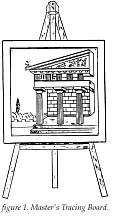 A
clear example of this confusion is found on page 28, of the last Dominion
Regalia catalogue which outlines two items for sale: first, something called
degree charts (which we would typically call Tracing Boards), and second,
something called the Master's Tracing Board. (see fig. 1.)
The Dominion Regalia has the correct description of a Master's Tracing Board,
specifically when it says that no regulation design is required. In fact, there
is no regulation design for any of these items, specifically the degree charts
or what we would call the Tracing Boards. For that reason I point out the
absolute incorrectness of the statement below the pictures of the Degree Charts:
"The only correct charts for Canadian or English work." There is no
authority for that statement; there is no Body in either England or Canada, to
the best of my knowledge, that has ever authorized the designs of any Tracing
Boards to be used. Whether the Grand Lodge should require the use of Tracing
Boards (as they do in this jurisdiction) is a different question. A
clear example of this confusion is found on page 28, of the last Dominion
Regalia catalogue which outlines two items for sale: first, something called
degree charts (which we would typically call Tracing Boards), and second,
something called the Master's Tracing Board. (see fig. 1.)
The Dominion Regalia has the correct description of a Master's Tracing Board,
specifically when it says that no regulation design is required. In fact, there
is no regulation design for any of these items, specifically the degree charts
or what we would call the Tracing Boards. For that reason I point out the
absolute incorrectness of the statement below the pictures of the Degree Charts:
"The only correct charts for Canadian or English work." There is no
authority for that statement; there is no Body in either England or Canada, to
the best of my knowledge, that has ever authorized the designs of any Tracing
Boards to be used. Whether the Grand Lodge should require the use of Tracing
Boards (as they do in this jurisdiction) is a different question.
The easiest way into the topic is to discuss the premises in which Masonic
meetings took place. You will notice I didn't use the word "lodge,"
because that word has a variety of different meanings–even now, we
interchangeably use the word to mean the place where we hold Masonic meetings
and the unit of Freemasonry that we belong to. These are recent developments for
the word, because the word has gone through a number of changes.
When talking about the Lodge,the best starting place is a very thorough
history such as The Lodge, An Essay in Method by R.J. Meekren. AQC ,Vol.
61 (1948). This gives a lot of history about the original "lodges" but
to make it brief, and to be specific, our concerns deal with the 18th century
and onward. We know that Freemasons met in rooms that were not designated solely
for the purposes of Freemasonry–that is, they met in back rooms of pubs, or
hotels or private residences. The room, therefore, had to not only be made to
look different during the meeting but also everything about the room had to go
back to normal, or at least non-Masonic. It was not a problem to move chairs and
candlesticks around, but those pieces of furniture did not make a room into a
lodge–that is, something that related to the original "form of the
Lodge."
Typically what was done was to draw on the floor (and this was the Tyler's
job) either an oblong or a slight variation of an oblong that represented the
form of the Lodge or the original enclosure of theoriginal outdoor Lodge
meetings. This original shape was typically called an oblong square. It got
renamed in the18th century to a word that has bedeviled us ever since: "parallelepipedon."
There's a remnant of earlier language used in the Senior Warden's lecture in the
First Degree; I quote from Page 45 of the Ancient Ritual: "Our ancient Brn.
usually met on a high hill or in a low dale, the better to detect the approach
of cowans or eavesdroppers either ascending or descending. The form of a L. is
an oblong, its length from E. to W., its breadth from N. to S., its height from
the earth to the heavens, its depth from the earth's surface to its center. It
is of such vast dimensions to show the universality of Fmy and that M. charity
should be equally extensive."
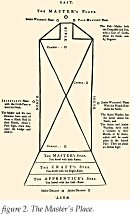 Just
to complete the cycle, the first reference to Hiram's grave is from the 1727
Wilkinson manuscript, where it is described, in a catechism, as an oblong
square. Sometimes the form of the Lodge would simply be this oblong square, and
sometimes the form of the Lodge would also include a variety of Masonic symbols.
We know this from prints in the early Masonic Exposures such as The Three
Distinct Knocks of 1760. (see fig. 2.) Just
to complete the cycle, the first reference to Hiram's grave is from the 1727
Wilkinson manuscript, where it is described, in a catechism, as an oblong
square. Sometimes the form of the Lodge would simply be this oblong square, and
sometimes the form of the Lodge would also include a variety of Masonic symbols.
We know this from prints in the early Masonic Exposures such as The Three
Distinct Knocks of 1760. (see fig. 2.)
This process of drawing the Lodge, and mopping up afterwards, is described in
The Three Distinct Knocks and in Jachin and Boaz and Mahhabone.
The process of cleaning up survives in our present ritual when at the end of the
meeting, as per the Antient Ritual (Page 167), the following is said:
"Nothing further remains to be done, according to ancient custom, except to
disarrange our emblems." I believe that this reference to disarranging
emblems refers to the cleaning up of the floor to leave no trace of the form of
the Lodge or the contents drawn thereon.
Gradually, and there really is no set time frame here, Lodges came up with
the idea of having Floor Cloths–that is, something that would be painted on
and could be used over and over. The first references to these Lodge floorings
that are painted occurs in French Exposures in the early 1740s. There are
diagrams and examples of these Floor Coverings and also a reference to the fact
that while some Lodges were using Lodge floorings, other Lodges refused to and
would only use the form of the Lodge that was drawn on the floor rather than
this newfangled invention. In fact there is a record of a Lodge Cloth being made
in 1812, after many Tracing Boards were already in use..3
There is a famous quote from 1759 in the Scottish Grand Lodge to the effect
that the Lodge St. Andrews had been ordered from ever using again a painted
flooring because "a painted cloth containing the flooring of a Master's
Lodge was hanging publicly exposed in a painter's shop," and the Grand
Lodge considered that some "pernicious consequences to Masonry" would
occur if this event occurred again. This is not a particularly accurate
expression of Freemasonry in Scotland at the time; there are a great number of
records of Scottish Lodges that were using these floorings for each of the
degrees, and in fact there are even records of some of these Floor Cloths,
because of their expense, being framed to be hung on the wall when the Lodge was
in session.
While the Scots may have been quite thrifty or at least very careful
regarding the Lodge's assets, by taking the form of the Lodge from the flooring
and putting onto the wall, they inadvertently changed the nature of Masonic
symbolism. You would no longer be standing around the Lodge itself or be part of
the Lodge itself but rather looking at the Lodge and all of the emblems
emblazoned thereon. This I think is one of the significant leaps away from
operative Masonry.
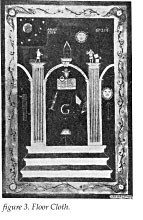 I
have to get back to the language issue at this point, because the words are
starting to change meanings. While the Lodge, that is those groups of men who
were Masons, decided to paint a Lodge cloth or Lodge floorings, what they were
doing is representing the Lodge and when they were standing around it or in a
room where the Lodge flooring was, then they were in the Lodge or at the Lodge
as compared to being members of the Lodge. In any event, the earliest floor
cloth that I can find a picture of is from 1764; that of the Lurgan Lodge No.
394 of the Grand Lodge of Ireland. (see fig. 3.) I
have to get back to the language issue at this point, because the words are
starting to change meanings. While the Lodge, that is those groups of men who
were Masons, decided to paint a Lodge cloth or Lodge floorings, what they were
doing is representing the Lodge and when they were standing around it or in a
room where the Lodge flooring was, then they were in the Lodge or at the Lodge
as compared to being members of the Lodge. In any event, the earliest floor
cloth that I can find a picture of is from 1764; that of the Lurgan Lodge No.
394 of the Grand Lodge of Ireland. (see fig. 3.)
There really was no centralized authority or convergence of information
regarding any of this, and all of these matters seemed to have sprung up either
spontaneously or contemporaneously in different parts of Europe. I won't go into
European or Irish Floor Cloths because that would make this just too
complicated. But the next step is the gradual change from Floor Cloths on the
floor to cloths that were designed specifically to be on raised boards.
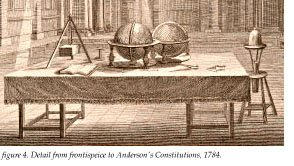 In
other words, rather than standing around or standing on a Floor Cloth the Lodge
would be formed when the cloth was on a board, which was usually suspended by
two trestles, therefore the phrase the trestleboard, or alternately the phrase
Lodge Board which also causes some ambiguity. What was put on the trestle board
were often at least the working tools in the degree that was to be worked. The
frontispiece of the 1784 Book of Constitutions shows a trestle board. (see
fig. 4) You will notice the two globes, the working tools, the Lewis,
the Volume of the Sacred Law, &c. In
other words, rather than standing around or standing on a Floor Cloth the Lodge
would be formed when the cloth was on a board, which was usually suspended by
two trestles, therefore the phrase the trestleboard, or alternately the phrase
Lodge Board which also causes some ambiguity. What was put on the trestle board
were often at least the working tools in the degree that was to be worked. The
frontispiece of the 1784 Book of Constitutions shows a trestle board. (see
fig. 4) You will notice the two globes, the working tools, the Lewis,
the Volume of the Sacred Law, &c.
I understand that there's a Lodge in Bristol that still uses a table with a
Lodge cloth on it.
Before I get to Tracing Boards there are a number of issues about drawing the
Lodge and the Lodge Floor Cloths and the Lodge Boards that need to be addressed.
back to top
EXPOSURES
After Freemasonry was established in France in the early 1730s, there were a
number of books printed that outlined the workings of a Lodge. These were called
Exposures because in theory they were meant to expose the workings to the
general public, but this is probably an inaccurate description. These books were
reprinted, some of them were translated and printed in English, (clearly the
market for the information was not limited just to people interested in what
Masons did but rather to Masons themselves) to find out how other Masons did
Ritual. Much of the early information we have is from these French and English
Exposures. For the longest time they were looked down on by scholars as being
inaccurate but, starting, at least, from Dring's paper on Tracing Boards
onwards, this has subtly changed where they are now seen as being the only
accurate representations of what Masonic Ritual was.
The first pictorial representation of Floor Cloths were found in the French
exposures dating back to 1742. We have some of these in the original form in our
Grand Lodge Library, unfortunately the diagrams I wish to use were not complete
and also unfortunately the Harry Carr book on early French exposures was
unavailable when I was collecting the diagrams for this lecture. In any event,
we know that Floor Cloths, in and of themselves were used as early as 1742,
specifically for the Third Degree.
FLOOR CLOTHS AND RELATED MATTERS
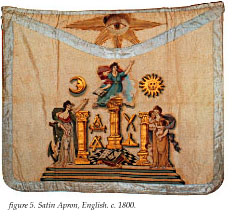 Floor
cloths and floor coverings are in fact a separate topic but I need to go through
them in some detail to tie up some loose ends. In many of our Lodge Halls, for
example, 8th & Granville, Marpole, and Kamloops, there is nothing on the
flooring that indicates the requirements of the First Degree Lodge, i.e.
Masonic pavement and indented skirting that surrounds the pavement. This can be
found in the First Degree lecture on page 42 of the Canadian work and similar
wording can be found in the Senior Warden's First Degree lecture on page 47 of
the Ancient Work. Why the flooring of these Lodge Halls is missing the Mosaic
pavement or the indented skirting is not for me to speculate. I know in my Lodge
hall in Richmond both these two items are there and in the Langford Lodge hall
on Vancouver Island there is an actual Mosaic pavement, and in the newly
refurbished Kerrisdale Lodge there is a wonderful carpet with Mosaic pavement
and also the four tassels. I raise this because the questions of symbolism and
use of Masonic symbols goes to the root of the history of where Tracing Boards
come from. If we rely on the Tracing Boards themselves for our sole source of
Masonic symbolism we may not only be taking too much for granted but also
diminishing the Masonic experience available to our Brethren. I can explain this
by talking about Lodges that meet in locations that are not permanent Masonic
Lodge halls. Typically, these are church halls or otherwise which the Masons use
for their meeting and have to make each hall to be a Masonic Lodge. Usually, the
Lodge will have some form of Masonic flooring. I refer you to photographs of the
AQC Vol.107 (1994) on pages 201 and 205 showing temporary tassels in the four
corners and a temporary Mosaic floor cloth of Lamont Lodge No. 94 of the Grand
Lodge of Alberta, and also the picture on page 157 of the AQC Vol.110 (1997). Floor
cloths and floor coverings are in fact a separate topic but I need to go through
them in some detail to tie up some loose ends. In many of our Lodge Halls, for
example, 8th & Granville, Marpole, and Kamloops, there is nothing on the
flooring that indicates the requirements of the First Degree Lodge, i.e.
Masonic pavement and indented skirting that surrounds the pavement. This can be
found in the First Degree lecture on page 42 of the Canadian work and similar
wording can be found in the Senior Warden's First Degree lecture on page 47 of
the Ancient Work. Why the flooring of these Lodge Halls is missing the Mosaic
pavement or the indented skirting is not for me to speculate. I know in my Lodge
hall in Richmond both these two items are there and in the Langford Lodge hall
on Vancouver Island there is an actual Mosaic pavement, and in the newly
refurbished Kerrisdale Lodge there is a wonderful carpet with Mosaic pavement
and also the four tassels. I raise this because the questions of symbolism and
use of Masonic symbols goes to the root of the history of where Tracing Boards
come from. If we rely on the Tracing Boards themselves for our sole source of
Masonic symbolism we may not only be taking too much for granted but also
diminishing the Masonic experience available to our Brethren. I can explain this
by talking about Lodges that meet in locations that are not permanent Masonic
Lodge halls. Typically, these are church halls or otherwise which the Masons use
for their meeting and have to make each hall to be a Masonic Lodge. Usually, the
Lodge will have some form of Masonic flooring. I refer you to photographs of the
AQC Vol.107 (1994) on pages 201 and 205 showing temporary tassels in the four
corners and a temporary Mosaic floor cloth of Lamont Lodge No. 94 of the Grand
Lodge of Alberta, and also the picture on page 157 of the AQC Vol.110 (1997).
I contacted some of the Lodges in our jurisdiction that don't have permanent
Masonic homes, and I can report that in Kitimat Lodge No. 169, which is
Canadian, they have a carpet that's about six feet by ten feet which on one side
has mosaic pavement and tassels, on the other side there's a coffin for the
Third Degree work. In McKenzie Lodge No. 168,which is an Antient Lodge, they
have a black and white mosaic pavement about six feet by six feet with tassels;
and in Queen Charlotte Lodge No.189, which is Antient, they have a Second Degree
Floor Cloth about two and a half feet by seven feet. In Light of the Rockies
Lodge No. 190, which is Emulation, they have a three foot by six foot painted
canvas Floor Cloth which is a mosaic pavement with tassels. This is not meant to
be an exhaustive list. I also do not want people to believe that only Lodges
that do not have a permanent home would use Floor Cloths. For example, Prince of
Wales Lodge No.100 (which meets at the Kerrisdale hall) has a black and white
Masonic pavement Floor Cloth which it uses; and Lodge of Edinburgh (Mary's
Chapel) No. 1, which just celebrated the four hundredth anniversary of its
earliest extant minute dating back to July 1559, also uses a Floor Cloth in what
is clearly a permanent Lodge hall. I refer any of you interested, to the Grand
Lodge of Scotland website to see a lovely picture of this.
This is as good as a place as any, to make some simple comparisons between
Antient and Canadian work. In Canadian work we typically only use the Floor
Cloth in the Third Degree. In Antient work there are no Tracing Boards as such
but there is usually a chart which is used by the Senior Warden in the First
Degree Lecture. In the Second Degree many Antient Lodges have wonderful Floor
Cloths, such as Vancouver Lodge No. 68. Richmond Lodge No. 142 lays out the
steps on separate pieces of wood marked with the appropriate names for the
three, five and seven steps. There are some Lodges in England that have
constructed winding staircases that the Candidate is actually guided up. In the
Third Degree, there is no specific reference to floor cloths in the Antient work
except in a wonderful lecture which is listed as Appendix
"H"–Alternate Lecture in MM Degree. The instructions in the Ritual
are that this lecture is to be delivered with slides or master's carpet. I wish
to thank the Grand Secretary for informing me of this piece of Antient ritual.
MASONIC SYMBOLISM
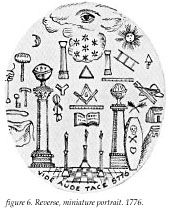 If
you were to only have read that Grand Lodge of Scotland reference about the
Floor Cloth, you might assume that Masons were opposed to decoration. Far from
it. In the Eighteenth Century Masons decorated not just Lodge regalia but
everything that could possibly be decorated. The Masonic museums are full of
drinking cups and glasses and plates and serving utensils covered in Masonic
emblems. Masons used to paint their aprons–in fact, that was one of the
compromises I mentioned earlier at the Lodge of Reconciliation that, in English
Masonry at least, there were to be no more hand-painted aprons, though this
certainly continued in Scotland. I've enclosed a copy of a hand-painted English
apron circa 1800 because it shows three women portraying Faith Hope and Charity.
This was a common portrayal and it shows up on a number of Tracing Boards,
specifically those by Bowring. (see fig. 5) I have also
enclosed the reverse side of a miniature portrait of Frances Cornelia, the wife
of James Ames, Master of Lodge Innocence and Morality in 1776. The vast majority
of information on all three Tracing Boards, save and except the Second Degree
stairway, is on the back of this miniature. I also point out that there were no
Tracing Boards in existence at the time this miniature was made, in other words
it is important to realize that the imagery used in the Tracing Boards was
imagery already known and accepted by Masons. (see fig. 6.) If
you were to only have read that Grand Lodge of Scotland reference about the
Floor Cloth, you might assume that Masons were opposed to decoration. Far from
it. In the Eighteenth Century Masons decorated not just Lodge regalia but
everything that could possibly be decorated. The Masonic museums are full of
drinking cups and glasses and plates and serving utensils covered in Masonic
emblems. Masons used to paint their aprons–in fact, that was one of the
compromises I mentioned earlier at the Lodge of Reconciliation that, in English
Masonry at least, there were to be no more hand-painted aprons, though this
certainly continued in Scotland. I've enclosed a copy of a hand-painted English
apron circa 1800 because it shows three women portraying Faith Hope and Charity.
This was a common portrayal and it shows up on a number of Tracing Boards,
specifically those by Bowring. (see fig. 5) I have also
enclosed the reverse side of a miniature portrait of Frances Cornelia, the wife
of James Ames, Master of Lodge Innocence and Morality in 1776. The vast majority
of information on all three Tracing Boards, save and except the Second Degree
stairway, is on the back of this miniature. I also point out that there were no
Tracing Boards in existence at the time this miniature was made, in other words
it is important to realize that the imagery used in the Tracing Boards was
imagery already known and accepted by Masons. (see fig. 6.)
back to top
RITUAL
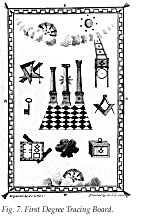 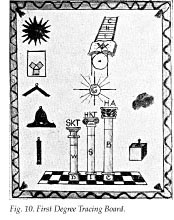 The
next step in understanding this story is the evolution of the Ritual. During the
Eighteenth Century there was a tremendous growth in Ritual. How Masonry was
practiced (at least, as far as we know) from the beginning of the Grand Lodge in
1717 to the end of the 18th century is so fundamentally different that it is
almost impossible to understand. For example, the first published Book of
Constitutions was written by Anderson and published in 1723. The title page
of that book states that the Constitution, that is the history of the laws, the
charges, the orders, the regulations and the usages were to be read at the
admission of new Brethren. This goes on for about another 48 pages, but on page
49 there's a second section to the book, which is known as the Charges of a
Free Mason. The contents of this, which goes on for 30 pages, is to be read
at the making of new Brethren or when the Master shall order it. It may be that
the early 18th Century people were prepared to read and listen to long, long
lectures. They certainly weren't by the end of the 18th Century. The
next step in understanding this story is the evolution of the Ritual. During the
Eighteenth Century there was a tremendous growth in Ritual. How Masonry was
practiced (at least, as far as we know) from the beginning of the Grand Lodge in
1717 to the end of the 18th century is so fundamentally different that it is
almost impossible to understand. For example, the first published Book of
Constitutions was written by Anderson and published in 1723. The title page
of that book states that the Constitution, that is the history of the laws, the
charges, the orders, the regulations and the usages were to be read at the
admission of new Brethren. This goes on for about another 48 pages, but on page
49 there's a second section to the book, which is known as the Charges of a
Free Mason. The contents of this, which goes on for 30 pages, is to be read
at the making of new Brethren or when the Master shall order it. It may be that
the early 18th Century people were prepared to read and listen to long, long
lectures. They certainly weren't by the end of the 18th Century.
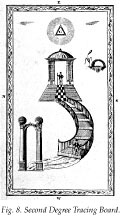 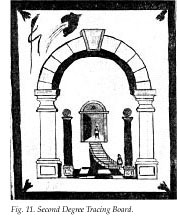 In
fact, the first unauthorized Masonic text to be printed in England after the
formation of Grand Lodge was Pritchard's Masonry Dissected of 1730, based
almost completely on catechism for its ritual work. This at least involved the
participation of the Masons, but whether it included the message that Anderson
wanted to get across is up in the air. I won't spend much time on this as it's
such a totally different topic and there's been so much written on it..4
Preston is a good place to recommence this analysis because his
book, Illustrations of Masonry, published in 1772 was a very popular
re-do of the catechism. It wasn't however, why Preston was so famous. In
fact, the first unauthorized Masonic text to be printed in England after the
formation of Grand Lodge was Pritchard's Masonry Dissected of 1730, based
almost completely on catechism for its ritual work. This at least involved the
participation of the Masons, but whether it included the message that Anderson
wanted to get across is up in the air. I won't spend much time on this as it's
such a totally different topic and there's been so much written on it..4
Preston is a good place to recommence this analysis because his
book, Illustrations of Masonry, published in 1772 was a very popular
re-do of the catechism. It wasn't however, why Preston was so famous.
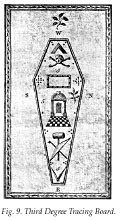 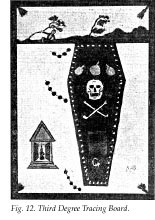 After
the success of his 1772 publication Preston developed his own lectures for the
Three Degrees and taught each of them separately. These degrees, which became
the basis of the Canadian Ritual that we use in this jurisdiction, were never
actually published by Preston. He taught them and worked them and in so doing he
was part of a somewhat larger crowd of late 18th Century Masonic scholars or
philosophers, or possibly even entrepreneurs, who wrote their own versions of
the Lectures, such as Finch, Cole and Browne. It is from the latter two that we
can get the first specific use of Tracing Boards. Both Cole and Browne devised
Tracing Boards as teaching methods for the First, Second and Third Degree
lectures. There were some earlier versions than the Cole and Browne version
which I have not included here, but they haven't been attributed and, frankly, I
have to use the best reproductions, which come from the Haunch article, not the
Dring article. There were some round Boards that were clearly for the First and
Second Degrees, and there were also some Floor Cloths about the same time that
were for the lectures in the First, Second and Third Degrees. Somewhere along
the line, the Degree work got relatively finalized and Lodges got used to seeing
not just Floor Cloths for the Lodge itself but also for the First, Second and
Third Degree Lodges. After
the success of his 1772 publication Preston developed his own lectures for the
Three Degrees and taught each of them separately. These degrees, which became
the basis of the Canadian Ritual that we use in this jurisdiction, were never
actually published by Preston. He taught them and worked them and in so doing he
was part of a somewhat larger crowd of late 18th Century Masonic scholars or
philosophers, or possibly even entrepreneurs, who wrote their own versions of
the Lectures, such as Finch, Cole and Browne. It is from the latter two that we
can get the first specific use of Tracing Boards. Both Cole and Browne devised
Tracing Boards as teaching methods for the First, Second and Third Degree
lectures. There were some earlier versions than the Cole and Browne version
which I have not included here, but they haven't been attributed and, frankly, I
have to use the best reproductions, which come from the Haunch article, not the
Dring article. There were some round Boards that were clearly for the First and
Second Degrees, and there were also some Floor Cloths about the same time that
were for the lectures in the First, Second and Third Degrees. Somewhere along
the line, the Degree work got relatively finalized and Lodges got used to seeing
not just Floor Cloths for the Lodge itself but also for the First, Second and
Third Degree Lodges.
It wasn't much of a leap to either attach these Floor Cloths to pieces of
wood making them Trestle Boards or painting directly onto Tracing Boards. The
Boards were not all of uniform size or shape, some were very large (six feet by
three feet) and some were painted such that there was the First Degree on one
side and the Second Degree on the other side, with a smaller handheld version of
the Third Degree Board. Other Boards were painted such that there was a hinge in
the middle, therefore allowing on one outside surface the First Degree, and on
the other outside surface the Second Degree and, when opened up, the Third
Degree in all its glory. These Tracing Boards were to be stood around and looked
down on when the lectures were given. The history of Tracing Boards is fairly
short, mainly because the cost of having Boards specially made for each Lodge
was quite high and they gradually became commercially produced. As far as I
know, the only hand-painted Tracing Boards in this Jurisdiction are used by
Burrard Lodge No. 50 and Duke of Connaught Lodge No. 64.
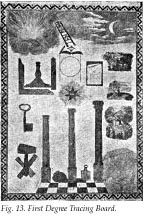  While
its clear that there was a tremendous growth of Ritual work towards the end of
the 18th Century and certainly after the union, or Lodge of Reconciliation, it's
wrong to assume that the Rituals that were used in England at that time (I'mcompletely
excluding Scotland and Ireland) changed overnight. By chance I ran across a
reference that in North Wales Province the delivery of the explanations of the
Tracing Boards was first given on March 21, 1872..5
What I propose to do now is go through the Tracing Board
artists in chronological order, and use the notes that Haunch uses on the pages
that I have reproduced. While
its clear that there was a tremendous growth of Ritual work towards the end of
the 18th Century and certainly after the union, or Lodge of Reconciliation, it's
wrong to assume that the Rituals that were used in England at that time (I'mcompletely
excluding Scotland and Ireland) changed overnight. By chance I ran across a
reference that in North Wales Province the delivery of the explanations of the
Tracing Boards was first given on March 21, 1872..5
What I propose to do now is go through the Tracing Board
artists in chronological order, and use the notes that Haunch uses on the pages
that I have reproduced.
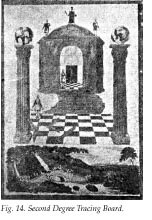 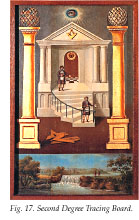 The
first of the artists is John Cole, who published Illustrations of Freemasonry
in 1801. There are three well known Tracing Boards, I'm informed, of
engravings from that publication. We have some copies of that first edition in
the Grand Lodge Library but none has or appears to have had any such engravings.
So don't go looking for the original engravings in our Library. (see figs. 7,
8, 9.) The
first of the artists is John Cole, who published Illustrations of Freemasonry
in 1801. There are three well known Tracing Boards, I'm informed, of
engravings from that publication. We have some copies of that first edition in
the Grand Lodge Library but none has or appears to have had any such engravings.
So don't go looking for the original engravings in our Library. (see figs. 7,
8, 9.)
The second artist is John Browne, who wrote Browne's Masonic Master Key
Through the Third Degrees in 1802. The pictures reproduced here are not
necessarily by Browne, but are attributed to his designs. John Browne, is of
interest for a few reasons. First of all, he was a teacher and the way that he
molded the lectures shows his interest in being able to communicate information;
.6 Browne is
also known because his book is in cypher. In fact, many Masonic books and charts
were in cypher, specifically the Ritual books; this was to make sure that
non-Masons didn't understand the Ritual but, of course, Masons had to buy books
that had the key for the cypher, otherwise they couldn't understand it. In
Browne's Master Key, the cypher was as follows: Substitute the vowels a e i o u
y with the letters of Browne's name; precede most words by meaningless capital
letters, and then substitute letters including c for e, and then substitute the
words Brethren or Masons with exclamation marks and then run the words together
indiscriminately and do not use punctuation. (see figs. 10,
11, 12.)
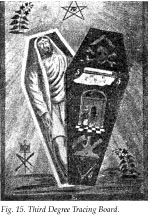 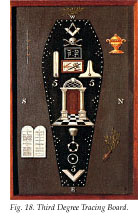 The
third artist is Jacob, who is only known to us by his last name. (see figs. 13,
14, 15) The
third artist is Jacob, who is only known to us by his last name. (see figs. 13,
14, 15)
The fourth artist is Josiah Bowring. He's generally acknowledged to be the
best of all as an artist and the pictures I have included come from a different
source than the Haunch article because I think they make better copies.(see
figs. 16, 17 18)
What you will notice in the First Degree, hanging from the Jacob's Ladder
right beside Hope–that is, the middle woman on the ladder–is a key. You will
also notice a key hanging in the First Degree Tracing Boards of Jacob and Cole.
This refers to a catechism which I have chosen to quote from AQC Vol.84 (l971)
page 327 because it is so interesting; it also indicates some of the material
that was lost, or has gone out of usage, with this reliance on Tracing Board
lectures:
Extract from Lectures of the Three Degrees, 1st Lecture, 1st Section:-
Q. How do they [the Masons] reveal them?
A. By Signs, tokens and particular words.
Q. As Masons, how do we hope to get at them?
A. By the assistance of a key.
Q. Does that key hang or lie?
A. It hangs.
Q. Why is the preference given to hanging?
A. It should always hang in a Brother's defense, and never lie to his
prejudice...
CHARGE
"That excellent key, a Freemason's tongue, which should speak well of a
Brother absent or present, but when unfortunately that cannot be done with
honour and propriety, should adopt the excellent virtue of the Craft, which is
silence."
back to top
CURRENT TRACING BOARD USAGE
Finally, I am enclosing probably the most famous of the Tracing Boards, done
by Harris for the Emulation Lodge of Improvement dated 1845. It is these and
other ones that he did that have been copied and adulterated which we now we use
as our Tracing Boards. (see figs. 19, 20,
21.)
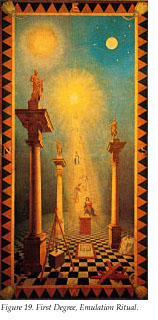 There's
another artist, Thissleton, who I have not included because the quality of the
reproduction wouldn't have been very good and there was nothing particularly
interesting about his artwork. There are some other unnamed artists that I also
cannot reproduce. I have, as much as possible, avoiding dealing with wall
hangings and other Masonic wall charts and Royal Arch Tracing Boards &c.,
&c. Those are subsidiary topics to what I'm dealing with and this is
complicated enough. There's
another artist, Thissleton, who I have not included because the quality of the
reproduction wouldn't have been very good and there was nothing particularly
interesting about his artwork. There are some other unnamed artists that I also
cannot reproduce. I have, as much as possible, avoiding dealing with wall
hangings and other Masonic wall charts and Royal Arch Tracing Boards &c.,
&c. Those are subsidiary topics to what I'm dealing with and this is
complicated enough.
I've also left out references to other similar Tracing Boards (the Harris
designs) because frankly they haven't been reproduced by either Haunch or Dring.
Both of them decided not reproduce them for particular reasons which I believe
are worth sharing. First from Dring and then from Haunch as follows:
"I have tried to put before you as concisely as possible the Evolution
and Development of the Lodge Board, and I have purposely refrained from entering
into the later developments made by Harris and the designers of the Victorian
era. They form a distinct chapter which would entail little labour for any
brother to write, but I must say the subject does not interest me. Erroneous
ideas, mistaken conceptions, meticulous details, in fact, all the bad qualities
of the Victorian age permeate them, and, to my idea, the sooner we return to the
pure realistic designs of Bowring or some of his contemporaries the
better."
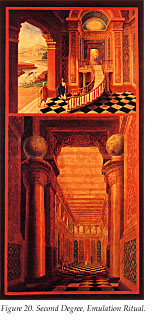 "In
their basic design, Harris' boards owe much to those of his predecessors,
particularly Bowring, although they lack the purity of style and balance of the
latter's work. The later examples exhibit the florid exuberance of ornament
beloved of Victorian taste, especially the Second Degree Board, whose
architecture is often a strange amalgam of Egyptian, Assyrian, Moorish and other
styles." "In
their basic design, Harris' boards owe much to those of his predecessors,
particularly Bowring, although they lack the purity of style and balance of the
latter's work. The later examples exhibit the florid exuberance of ornament
beloved of Victorian taste, especially the Second Degree Board, whose
architecture is often a strange amalgam of Egyptian, Assyrian, Moorish and other
styles."
I do not want to spend too much time on the "iconography" of the
Tracing Boards, because the use of two hundred years ago is a separate topic
completely, especially because some of the symbols have not been used in English
Masonry since the Lodge of Reconciliation although they are still being used in
other parts of the world. I cannot however leave this without discussing at
least one point of interest in each of the three Tracing Boards. In regard to
the First Degree Tracing Board, I refer to Browne Jacob and Harris , because
each of them has a Tracing Board for the Master to write lines on and in fact,
both Browne and Jacob show the 47th proposition.
In regards to the Second Degree Board, you will notice, if you look
carefully, that some of the stairs wind to the right and some of the stairs wind
to the left. This has sparked some debate as to which is the more accurate
description of the stairs–I haven't even mentioned these references because it
is not a topic that I find particularly worthwhile to investigate. There is,
however, the issue as to what each Lodge felt was the proper direction for the
stairways to go, and if you look at all the Second Degree Tracing Boards, except
the first one by Cole, there are no compass points on them; this would allow the
Lodge to have the Tracing Boards turned such that the stairs went whichever way
the Lodge determined they should be going.
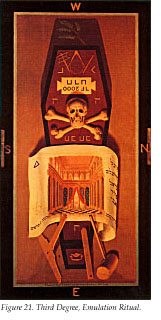 As
for the Third Degree Board, what initially strikes one is the coffin. Hiram
Abiff would have been buried only in a shroud not a coffin but the visual
representation of the coffin has been kept consistent by and large. There was
another confusing issue that I must deal with here and that is the lettering on
the Third Degree Board itself. On some of the boards there is a little bit of
Hebrew lettering but on most of the boards that are used in this jurisdiction,
the lettering that is on the coffin or around the coffin is not Hebrew at all
but a cypher which typically includes the Masonic year. As for the Masonic year,
if you are interested in tracing this, the best article I could find was
"The Dating of the Masonic Records," by Alan Bernheim, AQC Vol.99
(1986). As for the cypher, I enclose a copy of part of the Haunch article in
which he explains how to read the cypher. (see fig. 22.) As
for the Third Degree Board, what initially strikes one is the coffin. Hiram
Abiff would have been buried only in a shroud not a coffin but the visual
representation of the coffin has been kept consistent by and large. There was
another confusing issue that I must deal with here and that is the lettering on
the Third Degree Board itself. On some of the boards there is a little bit of
Hebrew lettering but on most of the boards that are used in this jurisdiction,
the lettering that is on the coffin or around the coffin is not Hebrew at all
but a cypher which typically includes the Masonic year. As for the Masonic year,
if you are interested in tracing this, the best article I could find was
"The Dating of the Masonic Records," by Alan Bernheim, AQC Vol.99
(1986). As for the cypher, I enclose a copy of part of the Haunch article in
which he explains how to read the cypher. (see fig. 22.)
Having said all of that I now enclose a Harris Third Degree Board that does
not conform to much of what I just said. First of all it shows an open grave
with a body in it, not a coffin, secondly, there is a fair amount of Hebrew on
the tombstone (another uncommon feature). In fact, the only cypher on there are
the six lines directly below the 47th proposition on the left hand side of the
tombstone. The three Hebrew letters that are placed adjacent to North, South and
East are identical and each has a numerical value of 5. It is typical to see
three 5s on these boards in relationship to the Hiramic Legend. (see fig. 23.)
I believe this covers off the majority of the knowable history of Tracing
Boards, and I now deal with the final questions as to why it is that we have
Tracing Boards in our Canadian Work and how it is that we use them.
To some extent this can be traced back and through some work done by the
Special Committee on Rituals between 1950 and 1954. I quote from the 1950 Grand
Lodge Proceedings (page 131):
In 1949 Grand Lodge adopted the following resolution on recommendations of the
Committee on Education and Research:
"That the Grand Master be requested to appoint a Special Committee to
investigate the matter of ritual and forms of work now in use in this Grand
Jurisdiction and to submit a report thereon to Grand Lodge."
We decided first to ascertain three things:-
1. What were the leading facts regarding the rituals being followed in the
Lodges of the Jurisdiction;
2. How other Jurisdictions, more particularly in Canada, were dealing with
the situation;
3. What Grand Lodge had done in the matter of Rituals to be observed by the
Lodges."
And from the 1951 Grand Lodge Proceedings (page 142):
"And study finally reveals that in British Columbia the spirit of
innovation has been abroad in the land. Some Lodges never open or close in due
form in the Second Degree. Some never hear of the All-seeing Eye. A
bewildering complexity has arisen. "
I further quote from page 147 of 1951:
"The Canadian system dates from 1859; it has many resemblances to the
English, but leans somewhat towards American, Scottish, and Irish practices.
The differences are sufficiently pronounced to warrant its consideration as a
separate system."
In 1952, the Committee reported on the different workings in the Province
regarding the lectures' explanations of the Tracing Boards. In 1953, the
Committee reported the Proceedings of the Grand Lodge of Canada in 1859. In
1954, the Committee, on page 150 of the Grand Lodge Report of that year,
presented its draft revised form of Canadian work and presented it to Grand
Lodge on the following terms:
"We propose, in accordance with our 1953 Report, to distribute a copy of
this Ritual to each Lodge in British Columbia and Yukon now doing Canadian
work, for its comment. We are not asking Grand Lodge at this Communication to
pass any resolution confirming this Ritual. The coming year may bring out
points which should be dealt with. Our idea is that this Ritual, after
approval by Grand Lodge, should be considered as a model and guide for the
Canadian work. We believe that no existing Lodge should be required to adhere
to it in every respect, but should adopt it, in whole or in part, as and when
the Lodge itself sees fit. But because of the prospect of such adoption,
perhaps some years hence, it is well to let every Lodge concerned have the
opportunity to look over this Ritual in its present form. No considerable
alteration has been made in the Ontario plan, but there have been some
changes, chiefly of wording."
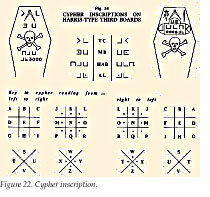 This
is consistent with all the Reports prior, where there was a real antipathy in
the Committee to having one standardized required Ritual. They felt their job
was to clean up the confusion, and to make the draft available and let the
Lodges agree to a written form of the Ritual as each Lodge saw fit. This
is consistent with all the Reports prior, where there was a real antipathy in
the Committee to having one standardized required Ritual. They felt their job
was to clean up the confusion, and to make the draft available and let the
Lodges agree to a written form of the Ritual as each Lodge saw fit.
That is not quite the way it turned out, because a resolution that was
presented in the 1955 Grand Lodge Proceedings was to the effect that any
Lodge working prior to June 1, 1954, would voluntarily adopt this Ritual but
that any Lodge formed after June 1, 1954, practicing Canadian work had to use
this agreed-upon Ritual.
This issue of required Rituals is far too complex for this paper, and it is
obvious that people wanted to have some regularity rather than uncertainty. But
the consequence, of course, is that it freezes everything in time such that, for
example, in my Lodge, we are contemplating using candlesticks as compared to
electric lights. There is general agreement that we can do this, and even come
up with a piece of floor work that lights the candles in a certain order, but
there is some question as to whether we can have any language used for this
piece of floor work because it may not be found in the 1954 Ritual.
 Seeing
as how I'm talking about Ritual, it's best to describe what actually happens in
the Tracing Boards lectures in Canadian work. Typically, the Candidate is
brought in after he's been through the Ritual Work and has sat down in front of
the Tracing Board. Usually in the First Degree this is somewhere between the
Junior Warden Station and the Jr. Deacon's position. The Junior Warden then
gives the lecture by pointing out all the elements of the Tracing Board. The
other lodge members are on the side-lines watching this performance. This is a
static and not particularly stimulating or participatory event. I know the
Junior Wardens wouldn't describe it that way because of the amount of memory
work involved. There are two different ways to deal with this. The first, if the
Tracing Board is big enough, is to lay it flat on the ground and have all the
Lodge Brethren stand around the Candidate while the lecture is being given. This
is done in some English Lodges but it would be impractical for a number of
reasons to do it in our Lodges. What has happened in a number of Canadian
Lodges, including my own, is that when the lecture is given the Candidate is
perambulated around the Lodge hall because almost every element of the First
Degree Tracing Board is present in the hall itself. So rather than use the
Figurative Lodge of the Tracing Board we indicate that the room that we're in
represents most of the elements as outlined in that Board. Seeing
as how I'm talking about Ritual, it's best to describe what actually happens in
the Tracing Boards lectures in Canadian work. Typically, the Candidate is
brought in after he's been through the Ritual Work and has sat down in front of
the Tracing Board. Usually in the First Degree this is somewhere between the
Junior Warden Station and the Jr. Deacon's position. The Junior Warden then
gives the lecture by pointing out all the elements of the Tracing Board. The
other lodge members are on the side-lines watching this performance. This is a
static and not particularly stimulating or participatory event. I know the
Junior Wardens wouldn't describe it that way because of the amount of memory
work involved. There are two different ways to deal with this. The first, if the
Tracing Board is big enough, is to lay it flat on the ground and have all the
Lodge Brethren stand around the Candidate while the lecture is being given. This
is done in some English Lodges but it would be impractical for a number of
reasons to do it in our Lodges. What has happened in a number of Canadian
Lodges, including my own, is that when the lecture is given the Candidate is
perambulated around the Lodge hall because almost every element of the First
Degree Tracing Board is present in the hall itself. So rather than use the
Figurative Lodge of the Tracing Board we indicate that the room that we're in
represents most of the elements as outlined in that Board.
Similarly, in the Second Degree Lecture, the Candidate has already gone
through the winding stairs and every other element of that lecture, by and
large, is also in the Lodge hall. Pointing out the pillars that are usually
situated somewhere near the west of the Lodge and all the material on the
pillars, rather than referring to the Tracing Board involves the Candidate and
shows not just the message of the Second Degree Lecture but also the fact that
it is incorporated into the furniture of the Lodge.
As for the Third Degree, the Tracing Board Lecture is really only three lines
long, but there's so much that has gone on that night that it's enough for the
Candidate to absorb. I also recommend, speaking of Third Degree Lectures, the
alternate Antient Lecture to be used for an educational night because it just
contains so much worthwhile information and it is possible to re-create a Lodge
Board or a Trestle Board and do a lecture that way.
This gets us finally to the issue as to whether or not we have to hide the
Tracing Boards for the Degrees in which they are not being worked. There is
nothing in our Ritual that requires any such thing. The usual reasons given for
not having the Boards on display are reasons that occur because we don't have
them on display as compared to reasons that would keep them from not being on
display. For example, sometimes one hears that you need to keep the right Board
out so that a member coming late to the Lodge knows what we are working in. Not
a bad argument, except by that logic no one entering an Antient Lodge (where
they don't use Tracing Boards) would have any idea of what they are doing. It is
actually the Tyler's job to tell the Brethren, and certain old English Lodges
have affixed to the outer door a square and compasses, and it is the Tyler's job
to move the points of the compasses depending on what Degree you are in–this
is a very sensible arrangement.
The other argument is that, by having the Second or Third Degree Tracing
Board exposed to view when there is a Mason who has not yet attained that
Degree, we are somehow imparting secrets. I think this has the secrecy argument
placed on its head. We have the working tools out at all times, regardless of
what Degree we are in and, we have both Pillars on display at all times and we
don't take the tassels down after the First Degree. When I visited Kamloops
Lodge No. 10 a few weeks ago, I noticed that all of their three Tracing Boards
are attached to the wall so that as soon as you walk into the Lodge you see them
all. I figure if it is good enough for at least one Past Grand Master and the
present Deputy Grand Master, it is good enough for me. On that point, I'll leave
this topic. I trust that this exposition has been of worth and interest.
back to top
ILLUSTRATIONS
Figure 1
The Master's Tracing Board. Reproduced from page 28, Dominion
Regalia Catalogue. 1999.

back to text back
to top
Figure 2
Floor diagram reproduced from The Three Distinct Knocks.
London: 1760.
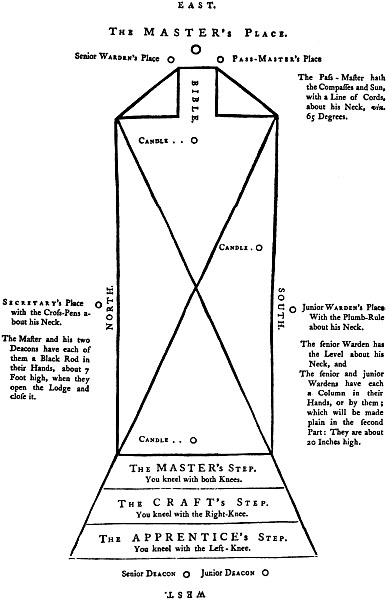
back to text back
to top
Figure 3
Floor Cloth. Dated 1764 of the Lurgan Lodge then No. 394
(Grand Lodge of Ireland).
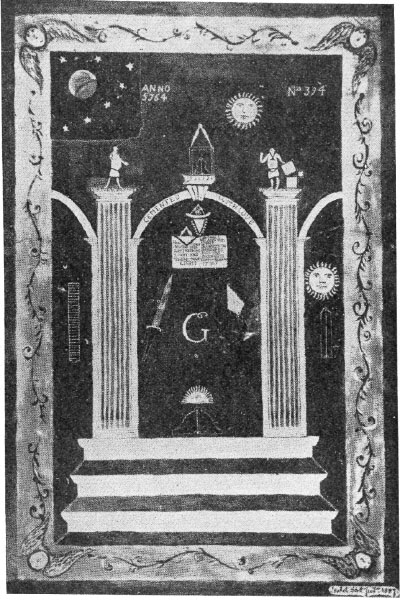
back to text back
to top
Figure 4
Frontispiece. Constitutions. Anderson. London:1782.
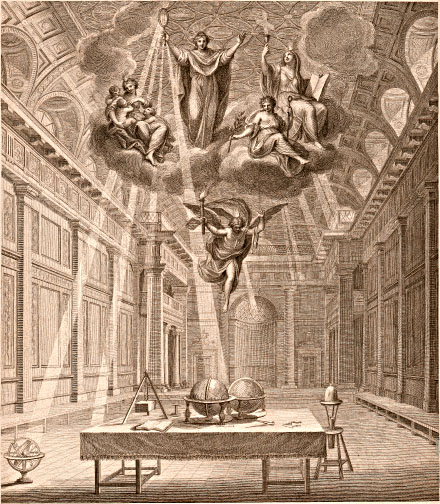
Frontispiece. Constitutions of the Antient Fraternity of Free and Accepted
Masons containing their History, Charges, Regulations, &. by James
Anderson. A new edition by John Noorthouk. J. Rouza, London: 1784. [plate drawn
by G.B. Cipriani and P. Sandby, engraved by F. Bartolozzi and J. Fittler.]
Explanation of the Frontispiece
The architectural part represents the inside of Freemasons'
Hall.The uppermost figure is Truth, holding a mirror, which reflects its
rays on divers ornaments of the Hall, and also on the Globes and other Masonic
Furniture and Implements of the Lodge. Truth is attended by the three
Theological Virtues, Faith, Hope and Charity: under these, the Genius of
Masonry, commissioned by Truth and her Attendants, is descending into the Hall,
bearing a lighted Torch; she is decorated with some of the Masonic Emblems, and
on her arm hangs a ribbon with a Medal pendant, with which she is to invest the
Grand Master, in token of the Divine approbation of a Building sacred to Charity
and Benevolence. [reprinted from an unnumbered page inserted after Abstract
of the Laws and before Sanction.]
Compare the architecture to that found in the Tours
of Dr. Syntax by William Coombe.
back to text back
to top
Figure 5
Satin apron, English, c. 1800 [p. 57,MacNulty]
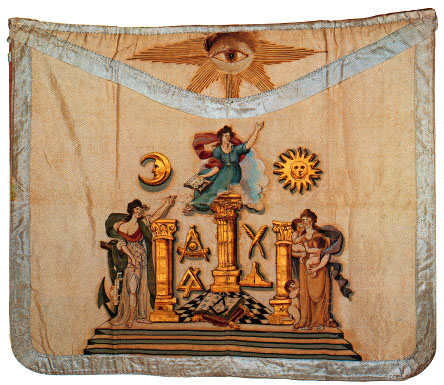
back to text back
to top
Figure 6
Reverse, miniature portrait of Francis Cornelia, wife of W.
Bro. James Ames, Lodge Innocence and Morality: 1776.[p. 69, MacNulty]
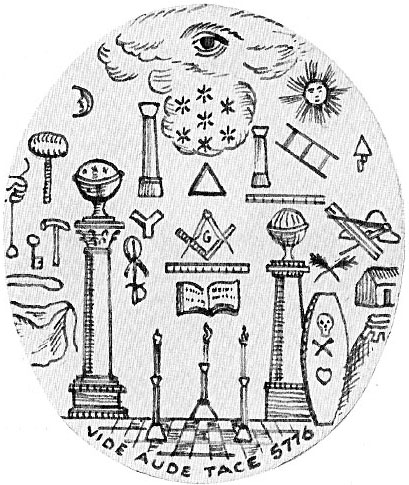
back to text back
to top
Figure 7
First Degree Tracing Board, engraved by F. Curtis, printed by
John Cole: 1801. [p.89, MacNulty]
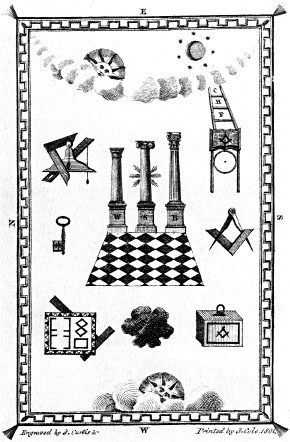
back to text back
to top
Figure 8
Second Degree Tracing Board, engraved by F. Curtis, printed by
John Cole: 1801. [p.78, MacNulty]
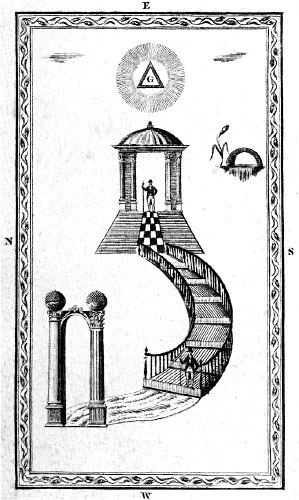
back to text back
to top
Figure 9
Third Degree Tracing Board, engraved by F. Curtis, printed,
John Cole: 1801. [p.280, AQC Vol. XXIX, 1916]
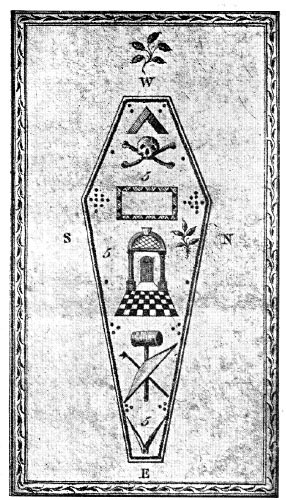
back to text back
to top
Figure 10
First Degree Tracing Board. John Browne's designs. c. 1800.
[p.192, AQC Vol. LXXV, 1962]
-labelling of pillars (as Cole, but cf. present ascriptions to Doric and Ionic);
master's tracing board.
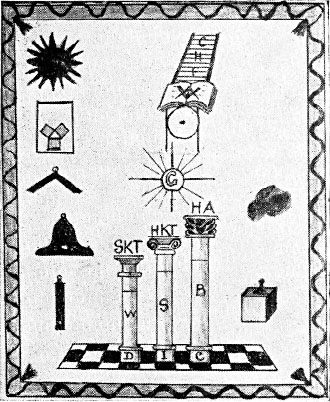
back to text back
to top
Figure 11
Second Degree Tracing Board. John Browne's designs. c. 1800.
[p.192, AQC Vol. LXXV, 1962]
-super-arch to entrance; winding staircase springing from south.
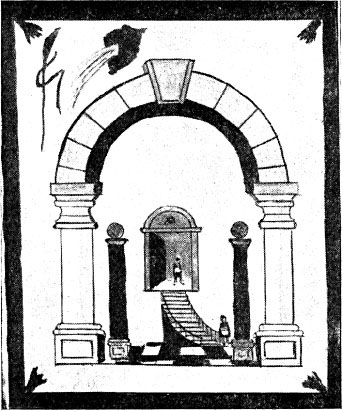
back to text back
to top
Figure 12
Third Degree Tracing Board. John Brownes's designs. c. 1800.
[p.192, AQC Vol. LXXV, 1962]
-objects like strings of beads, possibly representing three lodges of five F.C.s
each, topmost "lodge" completed by craftsman shown catching hold of
shrub.
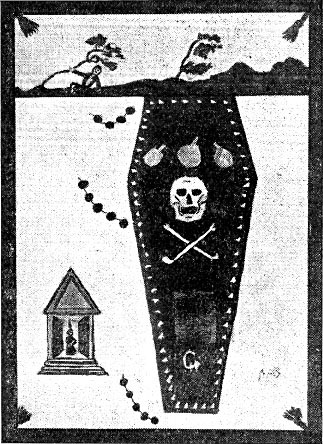
back to text back
to top
Figure 13
First Degree Tracing Board. Jacobs's designs. c. 1800. [p.192,
AQC Vol. LXXV, 1962]
- three sacrifice scenes of Abraham, Moses, Elijah (above setting sun, bottom
right); female figures of virtues on Ladders.
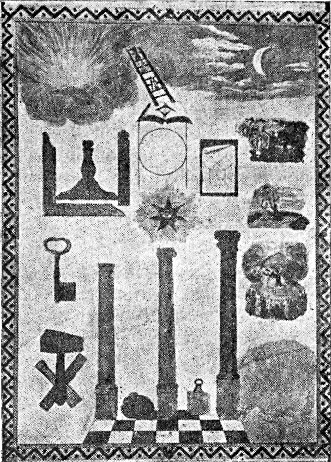
back to text back
to top
Figure 14
Second Degree Tracing Board. Jacobs's designs. c. 1800.
[p.192, AQC Vol. LXXV, 1962]
- figures of three G.M.s on domed roof of Middle Chamber; landscape with
waterfall, bridge, stream, &c.
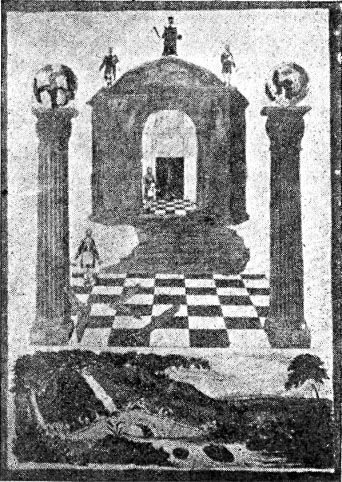
back to text back
to top
Figure 15
Third Degree Tracing Board. Jacobs's designs. c. 1800. [p.192,
AQC Vol. LXXV, 1962]
- pentalpha with all-seeing eye; open coffin; speculative working tools and
operative implements; date 3000 on inscription scroll.
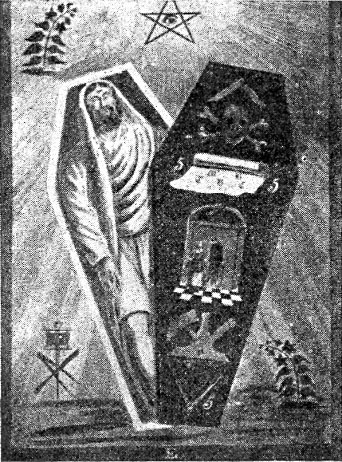
back to text back
to top
Figure 16
First Degree Tracing Board. Hand-painted on wood. Josiah
Bowring: 1819. [p. 48, MacNulty]
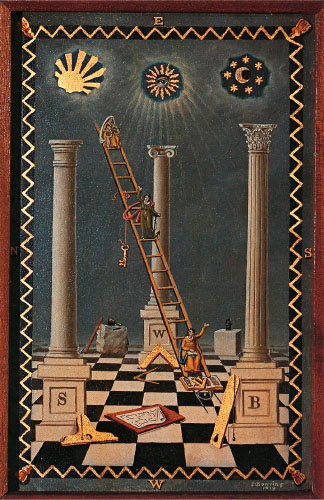
back to text back
to top
Figure 17
Second Degree Tracing Board. Hand-painted on wood. Josiah
Bowring: 1819. [pp. 48-49, MacNulty]
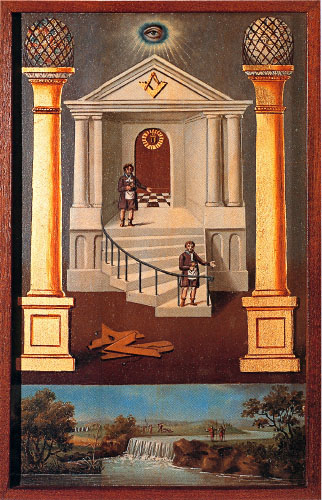
back to text back
to top
Figure 18
Third Degree Tracing Board. Hand-painted on wood. Josiah
Bowring: 1819. [p. 49, MacNulty]
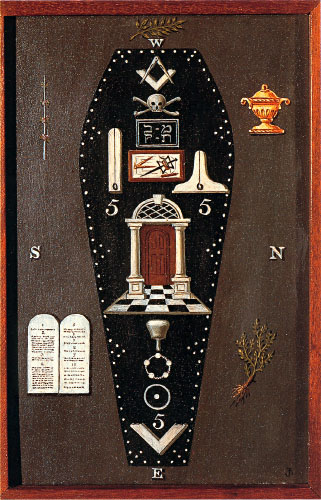
back to text back
to top
Figure 19
First Degree. Emulation Ritual. A. Lewis (Masonic Publishers)
Ltd. Middlesex: 1976.

back to text back
to top
Figure 20
Second Degree. Emulation Ritual. A. Lewis (Masonic Publishers)
Ltd. Middlesex: 1976.
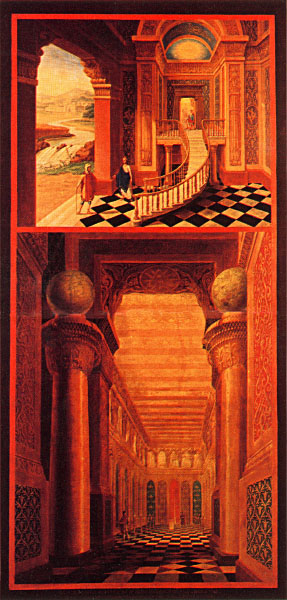
back to text back
to top
Figure 21
Third Degree. Emulation Ritual. A. Lewis (Masonic Publishers)
Ltd. Middlesex: 1976.
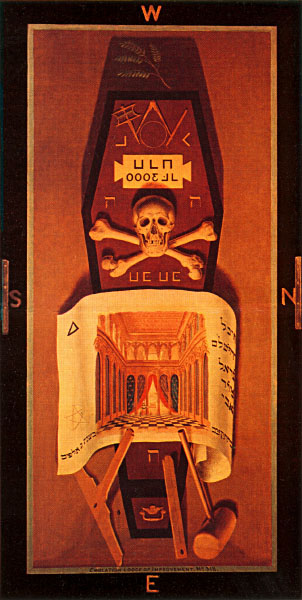
back to text back
to top
Figure 22
Cypher Inscriptions on Harris-type Third Degree Boards.
[p.202, AQC Vol. LXXV, 1962]
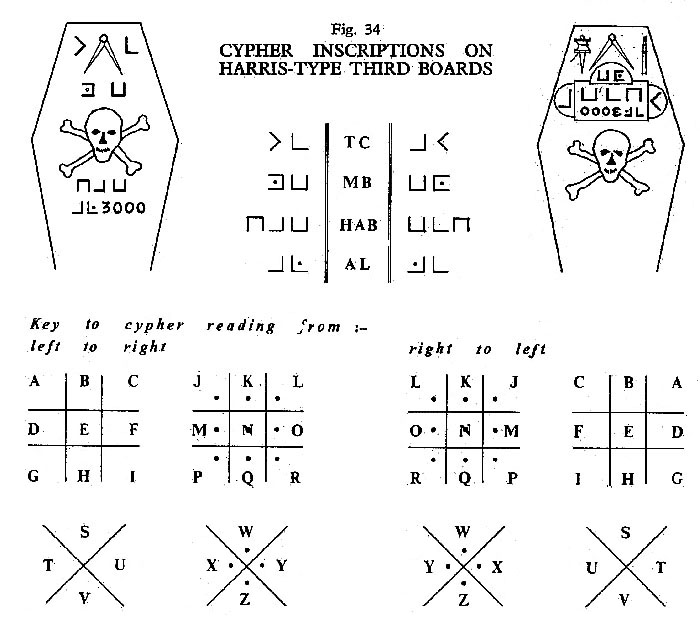
back to text back
to top
Figure 23
A Fine Board by J. Harris. 1850.
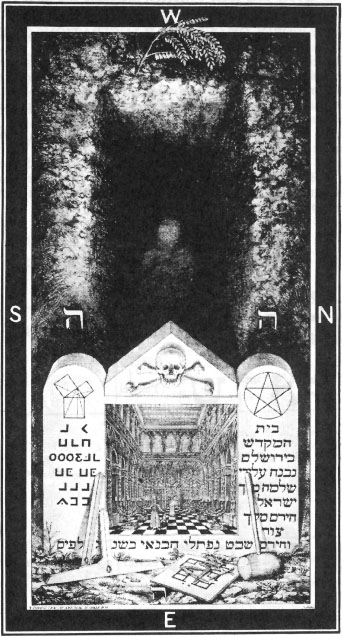
back to text back
to top
ENDNOTES
1. Freemasonry, A Journey through Ritual and Symbol.
W. Kirk MacNulty. Thames and Hudson Ltd, London: 1991. ISBN 0-500-81037-0^
2. It is not in the power of any man. T. O. Haunch. Ars
Quatuor Coronatorum 85 (1972).Transactions of Quatuor Coronati Lodge No.
2076: London.^
3. Ars Quatuor Coronatorum Vol. 64 (1953) p. 79.
Transactions of Quatuor Coronati Lodge No. 2076: London.^
4. The Lectures of English Grand Freemasonry. P.R.
James. AQC Vol. 79 . London:1966. The First Lecture of Freemasonry by William
Preston. P.R. James AQC Vol. 82. London: 1969. ^
5. Ars Quatuor Coronatorum Vol.92. London:1979. page
52.^
6. The Third Man, The Study of Browne's Master Keys.
Douglas Vieler, AQC Vol. 105. London:1992.^
back to top
|
![]()


















































